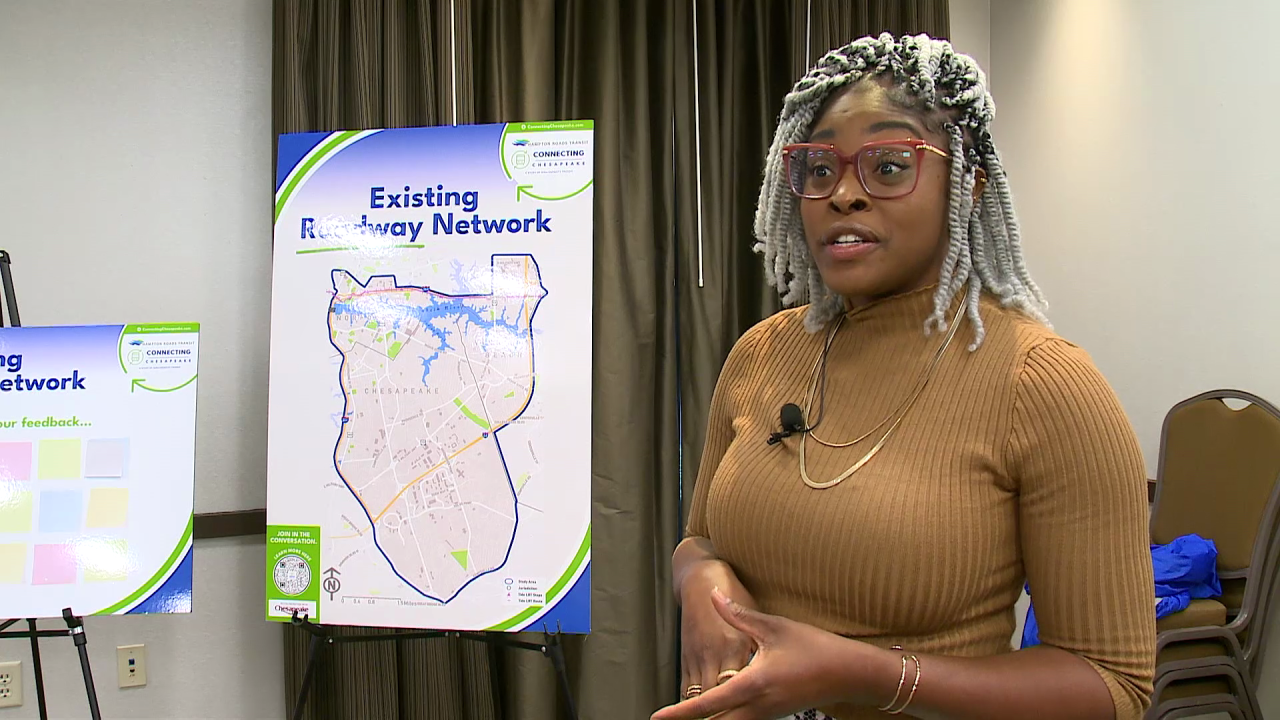CHESAPEAKE, Va. — Hampton Roads Transit is talking about the idea of bringing high-capacity transit to Chesapeake. Officials are holding public meeting sessions to get feedback and to hear from people about what they would like to see.
HRT is conducting a study known as "Connecting Chesapeake."
According to Hampton Roads Transit, the Moving Forward Chesapeake 2035 Comprehensive Plan and 2050 Master Transportation Plan show a need for a "multi modal transportation system to support regional mobility and accessibility for Chesapeake residents."

News
READ MORE: Congressman Bobby Scott tours Hampton Roads Transit facilities
HRT defines 'high-capacity transit' as a "form of public transit that typically operates in its own lane or right-of-way. These vehicles generally make fewer stops, travel at higher speeds, have more frequent service and carry more people than local transit service."
Jeremy Wooland relies on the bus every day. He was waiting at the Robert Hall Transfer Center Tuesday evening.

"I mean if there weren't a bus right now, I'd be having to hoof it or bike it or figure it out," Wooland said. "I'd be paying for a whole lot more Ubers, but they're costly."
He told News 3's Jay Greene he'd like to see improvements to the service.
"The Chesapeake buses need to run longer," he said.
Tuesday night, Hampton Roads Transit held the first of three meetings designed to educate people about high-capacity transit and provide a vision.

Transit options would include an express bus, which would have fewer stops than a regular bus, or something called bus rapid transit or BRT.
"It can operate in its own fixed guideway, has level boarding, off-board fare payment, it is fast and reliable," said Sherri Dawson, the director of transit development with Hampton Roads Transit.

Dawson told Greene the study area covers the busy transit areas of Chesapeake, and it also includes portions of Norfolk—like Norfolk State and Military Circle—and Virginia Beach.

"As far south as the Chesapeake Regional Medical Center," Dawson said. "We're also looking at points of interest like Summit Point area, the Sam's Club Circle shopping center—we know that's a big, a major place in the city of Chesapeake—as well as Robert Hall transfer center."

Consumer
DID YOU SEE THIS? More money available for vanpool groups through HRT's TRAFFIX program
Among of the options could be a light rail, according to the study brochure.
But a reminder from Dawson—it doesn't mean Chesapeake is actually getting a light rail.
"Our vision is for it to tie into the Tide (light rail in Norfolk), but when we say 'tie into the Tide,' it doesn't necessarily need to be light rail," Dawson said. "So a step below light rail will be bus rapid transit. So similar amenities to what light rail has."
Brenda Smith-Watson, of Chesapeake, said as the community grows, she feels the transit system is behind-the-times.

"We have to keep up with the modern times," she said. "The buses take forever to come for people waiting over an hour, and then they shut off at a certain time," she said.
Smith-Watson said she'd also like to see an option that includes better connecting the seven cities.
"With the congestion going on now to the to the Naval bases, going over to the Peninsula, and the downtown areas...really a need for an upgrade in our system," she said.
Greene also spoke with Rhi Smith who lives in Chesapeake. She said she sees the need while driving to work.
"It's five minutes away from my house, driving it takes me 10 minutes to get to work every morning simply because there's traffic. I hit every light on my way to work every morning," Smith said. "Driving is kind of not great. Walking isn't fun either because it's right up Battlefield to get to work every morning. If I walked there, it's kind of nerve-wracking to have the sidewalk right there and then also road."
HRT said community feedback is crucial to the next part of the process.
There are two more meetings the public can attend. A pop-up event runs from 2 to 4 p.m. on Oct. 18 at the Robert Hall Transfer Center. It's on Robert Hall Boulevard and Military Highway.
A third meeting on Oct. 19 starts at 4 p.m. at South Norfolk Memorial Library at 801 Poindexter St.

"We have data, we have numbers," Dawson told Greene. "So that only tells us that piece of the puzzle. People that live here, work here, they are our eyes, and they see things that the data doesn't show. So the feedback is gonna complement what numbers are showing us."
According to the schedule, the study will wrap up in the fall of 2024. Hampton Roads Transit will take the feedback and make a decision on how to move on to the next phase.

"How are we going to get from the study area and connected to the Tide, and then we're also going to look at different technologies—whether that's express bus, bus rapid transit or light rail. So that's going to be the tier one," Dawson said. Tier two, we're going to narrow those down into the most cost effective and feasible options and then hopefully come up with one or two options that can move forward into further analysis."




